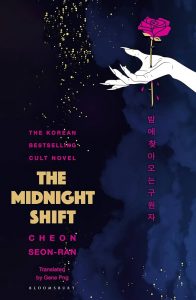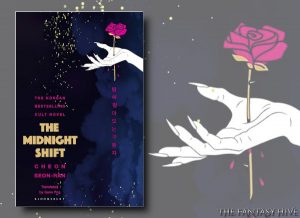THE MIDNIGHT SHIFT by Cheon Seon-Ran, Translated by Gene Png (BOOK REVIEW)
A bestseller in Korea, a biting, fast-paced vampire murder mystery exploring queer love and the consequences of loneliness.
When four isolated elderly people commit suicide back-to-back at the same hospital by jumping out of the sixth-floor window, Su-Yeon doesn’t understand why she’s the only one at her precinct that seems to care. Dismissing the case as a series of unfortunate events due to the patients’ loneliness, the police force doesn’t engage. But Su-Yeon doesn’t have the privilege of looking away. Her dearest friend, Grandma Eun-Shim, lives on the sixth floor, and Su-Yeon is terrified that something will happen to her next.
As Su-Yeon begins her investigation alone, she runs into a mysterious woman named Wanda at the crime scene. Wanda, hot on the trail of her ex-lover, Lily, gives Su-Yeon the answer: a vampire did it. Su-Yeon is skeptical at first, but then a fifth victim jumps from the window and her investigation reveals the body was completely drained of blood. Desperate to discover the cause of the deaths, Su-Yeon considers Wanda’s explanation—that something supernatural is involved.
The Midnight Shift is a gripping mystery, overflowing with commentary about societal isolation and loneliness, the sharp knife of grief, and the effects of marginalization, perfect for readers of Cursed Bunny; Woman, Eating; and A Certain Hunger.
 There is something about the concept of vampires that defies the confines of trope. My recent reading includes V.E. Schwab’s Bury our Bones in the Midnight Soil, which tweaked the powers and vulnerabilities of vampires in interesting ways, introducing some perilous costs to be paid for a bloody immortality. Then there was Emma Newman’s Vengeance which filled the court of 17th century France with avaricious blood suckers (Probably not too historically inaccurate, given the toxic inequalities that Louis XIV’s reign ushered in). Cheon Seon-Ran’s tale The Midnight Shift takes another oblique perspective on the ancient exsanguinators, with this tale of vampires stalking the corridors of a Korean Care-home-cum-hospital for the elderly and senile.
There is something about the concept of vampires that defies the confines of trope. My recent reading includes V.E. Schwab’s Bury our Bones in the Midnight Soil, which tweaked the powers and vulnerabilities of vampires in interesting ways, introducing some perilous costs to be paid for a bloody immortality. Then there was Emma Newman’s Vengeance which filled the court of 17th century France with avaricious blood suckers (Probably not too historically inaccurate, given the toxic inequalities that Louis XIV’s reign ushered in). Cheon Seon-Ran’s tale The Midnight Shift takes another oblique perspective on the ancient exsanguinators, with this tale of vampires stalking the corridors of a Korean Care-home-cum-hospital for the elderly and senile.
The protagonist Suyeon is a detective called to another suicide – a seventy-four year old jumper from the sixth floor of the building who has left a cryptic suicide note and surprisingly little blood spatter on the asphalt where he fell. Suyeon is assisted by the silver haired enigmatic form of Violette, Korean by birth but adopted by French parents at a very young age.
Cheon’s narrative follows two timelines. There is the present time of Suyeon’s increasingly incredulous investigation, as Violette presents evidence of supernatural lives and impossible acts. There is also the past timeline of a key point in Violette’s life in France, 1983, when as a teenager she discovered a friend and events launched her on a career of vampire hunting. Cheon also gives us a third point of view voice, the nurse Nanju who has her own troubles and takes some very questionable steps to address them.
Cheon gifts her female leads with strong voices born of difficult back-stories. Suyeon is haunted by an enduring sense of loss from the death of the mentor who first urged her into detective work. Nanju’s difficult relationship with her father still fills her dreams and make sleep elusive without medical assistance. Violette, returning to the land of her birth, is still hoping to recover the friendship she lost in France decades earlier.
In The Midnight Shift Cheon brings fresh refinements to vampiric lore. The rules bound nature of the monsters was first alluded to in Bram Stoker’s masterpiece with the idea that vampires must be invited over a threshold. In Cheon’s case there is a sort of memorandum of understanding – almost a legal agreement – between the vampire community and those who hunt them. Vampires cannot be attacked unless they are killing the unwilling – which you might think was a pretty low bar for intervention. However, this drives Cheon’s second innovation – or perhaps adaptation by the night walkers. Her vampires prey on the lonely, the desperate, like the dark websites that exploit people’s misery, encourage their despair and educate them in how to end their existence. I once watched T.S. Eliot’s play Murder in the Cathedral about the assassination of Thomas a Becket by four rogue knights of Henry II. At the end of the brutal killing the four knights face the audience to explain themselves and, in setting out Becket’s deliberately provocative acts and careless disregard for his own safety, encourage the audience to judge his death a case of suicide. With similar legerdemain, Cheon’s shadowy antagonist seeks to excuse himself of any wrong-doing and evade retribution by the vampire hunters.
 This quasi-legal loophole naturally draws the vampires towards the lonely, and Cheon’s novel probes deep into that modern ailment. There is an irony that even as the internet and technology has made the world more connected than ever before, we seem to be living through something of a loneliness epidemic. For the patients confined in Cheon’s hospital for the senile and dementia ridden, neglected by their relatives and only fleetingly entertained by Nanju’s origami classes, it is as if lockdown never ended. Yet, even back in 1983, Violette – the Korean girl with the French parents – struggles to build relationships beyond her close family group, a vulnerability that draws vampiric attention like moths to a flame.
This quasi-legal loophole naturally draws the vampires towards the lonely, and Cheon’s novel probes deep into that modern ailment. There is an irony that even as the internet and technology has made the world more connected than ever before, we seem to be living through something of a loneliness epidemic. For the patients confined in Cheon’s hospital for the senile and dementia ridden, neglected by their relatives and only fleetingly entertained by Nanju’s origami classes, it is as if lockdown never ended. Yet, even back in 1983, Violette – the Korean girl with the French parents – struggles to build relationships beyond her close family group, a vulnerability that draws vampiric attention like moths to a flame.
Tensions in the past and the present timelines build to tense denouements as Suyeon now, and Violette then, must confront their respective nemeses and accept the reality of those that walk amongst us. Cheon’s vampires come across not so much as a fundamental enemy of humanity, and more a natural consequence of our social failings. Like all the best villains, Cheon’s antagonist sees himself as simply following the obvious, inevitable – maybe even the best possible course of actions, given his context and circumstances. In the final uncertain combat – where the survival of any character is in doubt – he insists, with childish petulance, You have no right to resent me, I’ve done you no wrong.
This is of course a book translated from Korean and much credit must go to the translator Gene Png for converting Cheon’s original into a version accessible to and enjoyable by an anglophone readership. There was one moment of confusion for me in that my ARC has the Korean convention to its cover, where the book spine is on the right (although the opening of the pages inside follow the western pattern). This meant initially I thought the back cover was the front cover, and mistook the brief back cover blurb comment Love is the Most Despicable Excuse for the book’s title. To be honest, I don’t think that would be a bad title either.
Translation is very much an art and it is dismaying to see that some publishers think this process could be parcelled off to AI. As with other AI innovations, one could expect to see machines taking over the majority of the jobs with a few humans retained to act as overworked underpaid quality assurance checking the dubious output of the AI systems for the more egregious errors. So it’s important that the work of Gene Png and other translators is recognized and appreciated. Translation is the lens through which we view a foreign language work, and the quality of that lens plays a big part in the clarity and fidelity of the story we perceive.
For example in this description of an evening Violette passed in 1983.
Clouds are prettier at night. You can’t look at the sun, but you can stare at the moon, and while the sun steals the spotlight, the moon shares it with the stars.
Or here where the antagonist sets out his blood sucking philosophy.
‘“Survival is the only way to prove strength.” I’m sure you’d agree with that sentiment. No matter how dreadful a human being is, they become nothing when they’re dead, reduced to a mere parasite scuttling about in the memory of the living.’
Through the translation we are also given an insight into the culture of Cheon’s Korea, its cuisine and its courtesies, which is another reason for being grateful to the translators that open new settings and experiences to broaden the anglophone perspective.
Nonetheless, what we see through The Midnight Shift is not just a different country, but also familiar problems and similar human challenges. It is perhaps those commonalities – for example that worldwide experience of wanting to connect, to be a part of something with someone else – that makes the trope of vampires such an effective common denominator through which to interrogate (and divide?) humanity.
The Midnight Shift is available now – you can order your copy from Bookshop.org

